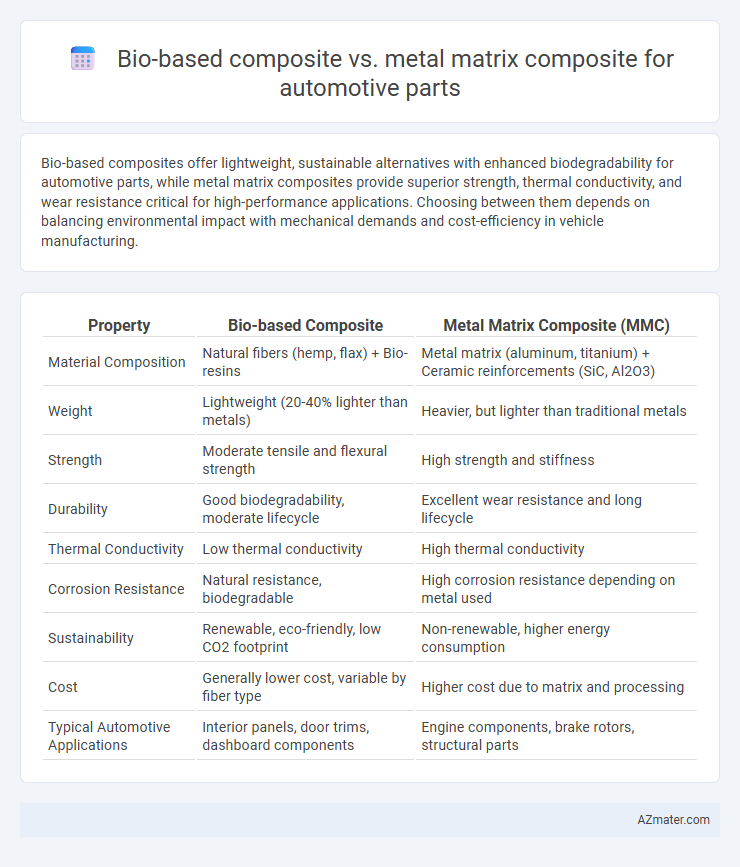Bio-based composites offer lightweight, sustainable alternatives with enhanced biodegradability for automotive parts, while metal matrix composites provide superior strength, thermal conductivity, and wear resistance critical for high-performance applications. Choosing between them depends on balancing environmental impact with mechanical demands and cost-efficiency in vehicle manufacturing.
Table of Comparison
| Property | Bio-based Composite | Metal Matrix Composite (MMC) |
|---|---|---|
| Material Composition | Natural fibers (hemp, flax) + Bio-resins | Metal matrix (aluminum, titanium) + Ceramic reinforcements (SiC, Al2O3) |
| Weight | Lightweight (20-40% lighter than metals) | Heavier, but lighter than traditional metals |
| Strength | Moderate tensile and flexural strength | High strength and stiffness |
| Durability | Good biodegradability, moderate lifecycle | Excellent wear resistance and long lifecycle |
| Thermal Conductivity | Low thermal conductivity | High thermal conductivity |
| Corrosion Resistance | Natural resistance, biodegradable | High corrosion resistance depending on metal used |
| Sustainability | Renewable, eco-friendly, low CO2 footprint | Non-renewable, higher energy consumption |
| Cost | Generally lower cost, variable by fiber type | Higher cost due to matrix and processing |
| Typical Automotive Applications | Interior panels, door trims, dashboard components | Engine components, brake rotors, structural parts |
Introduction to Automotive Composite Materials
Bio-based composites offer lightweight, sustainable alternatives with high specific strength derived from natural fibers such as flax or hemp, reducing vehicle emissions and improving fuel efficiency. Metal matrix composites (MMCs) integrate metals like aluminum or magnesium with ceramic reinforcements, providing superior mechanical properties, thermal stability, and wear resistance for high-performance automotive parts. Both materials enhance vehicle durability and performance, yet bio-based composites emphasize environmental benefits, while MMCs prioritize strength and thermal management.
Defining Bio-Based Composites
Bio-based composites consist of natural fibers such as hemp, flax, or jute embedded in a polymer matrix derived from renewable resources, offering reduced environmental impact and lower weight compared to metal matrix composites. These composites provide excellent biodegradability and sustainability advantages ideal for automotive parts requiring lightweight materials with good mechanical properties. In contrast, metal matrix composites combine metals like aluminum with ceramic reinforcements to achieve superior strength and heat resistance but involve higher energy consumption and environmental costs.
Overview of Metal Matrix Composites
Metal Matrix Composites (MMCs) consist of metal matrices reinforced with ceramic fibers or particles, offering superior strength, stiffness, and thermal resistance compared to traditional metals. Commonly used metals include aluminum, magnesium, and titanium, which enhance automotive part performance by reducing weight and improving wear resistance. MMCs are preferred in high-stress automotive components such as brake rotors and engine parts due to their excellent mechanical properties and ability to withstand harsh operating conditions.
Comparative Material Properties
Bio-based composites offer lower density and enhanced sustainability compared to metal matrix composites, resulting in lightweight automotive parts with reduced environmental impact. Metal matrix composites provide superior mechanical strength, thermal conductivity, and wear resistance, making them ideal for high-performance engine components. While bio-based composites excel in corrosion resistance and cost-effectiveness, metal matrix composites outperform in stiffness and load-bearing capacity essential for structural applications.
Weight Reduction and Performance Impacts
Bio-based composites offer significant weight reduction in automotive parts due to their low density and renewable fiber content, enhancing fuel efficiency and lowering emissions. Metal matrix composites provide superior mechanical strength and thermal stability, improving performance in high-stress applications but often at the expense of increased weight. Balancing weight reduction with durability, bio-based composites are preferable for interior components, while metal matrix composites suit engine and structural parts requiring enhanced load-bearing capabilities.
Environmental Sustainability and Lifecycle Analysis
Bio-based composites offer significant environmental sustainability advantages over metal matrix composites in automotive parts due to their renewable raw materials and lower carbon footprint during production. Lifecycle analysis reveals bio-based composites have reduced energy consumption and greenhouse gas emissions from manufacturing to disposal, enhancing circular economy potential through biodegradability or recyclability. Metal matrix composites provide superior mechanical strength but entail higher environmental costs linked to mining, processing, and end-of-life recycling challenges driven by energy-intensive extraction and material separation.
Cost Considerations in Manufacturing
Bio-based composites offer significant cost advantages over metal matrix composites (MMCs) in automotive manufacturing due to lower raw material and energy expenses. Metal matrix composites require expensive metal alloys and intricate processing techniques, which increase production costs and limit scalability. The reduced tooling wear and shorter cycle times associated with bio-based composites further enhance manufacturing cost efficiency for automotive parts.
Applications in Automotive Component Design
Bio-based composites are increasingly utilized in automotive component design for interior parts such as door panels, dashboards, and seat backs due to their lightweight nature, sustainability, and excellent vibration damping properties. Metal matrix composites offer superior strength, thermal conductivity, and wear resistance, making them ideal for critical engine components, brake systems, and structural parts requiring high mechanical performance. Integration of bio-based composites supports weight reduction and eco-friendly design goals, while metal matrix composites enhance durability and heat management in demanding automotive applications.
Challenges and Limitations of Each Composite
Bio-based composites for automotive parts face challenges such as lower mechanical strength and durability compared to metal matrix composites, alongside higher susceptibility to moisture absorption and thermal degradation. Metal matrix composites offer superior mechanical properties and heat resistance but present limitations including higher production costs, complex manufacturing processes, and difficulties in recycling. Both materials encounter challenges in achieving optimal balance between performance, cost, and environmental impact for widespread automotive application.
Future Trends and Recommendations for Automotive Industry
Bio-based composites are gaining traction in the automotive industry due to their lightweight, sustainability, and lower carbon footprint compared to traditional metal matrix composites, which offer superior strength and heat resistance. Future trends indicate a hybrid approach combining bio-based fibers with metal matrices to optimize mechanical performance and environmental impact. Automotive manufacturers should invest in research for scalable bio-composite production and develop hybrid material design strategies to meet stricter emission regulations and consumer demand for eco-friendly vehicles.

Infographic: Bio-based composite vs Metal matrix composite for Automotive part
 azmater.com
azmater.com